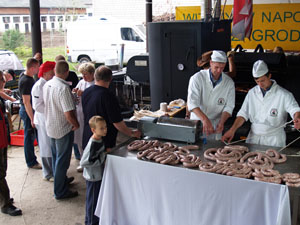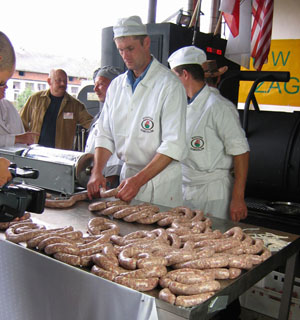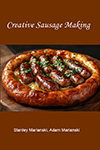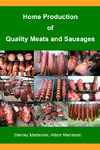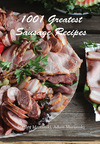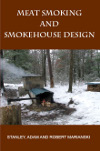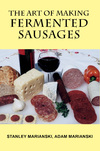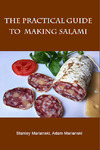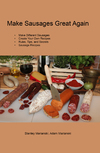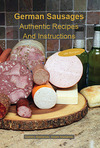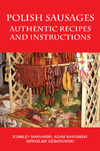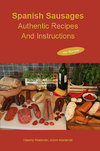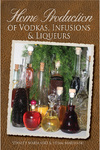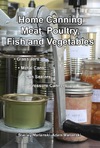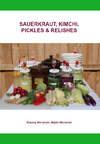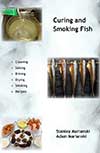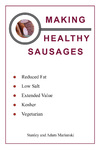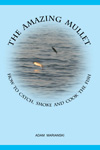Meats and Sausages
History of Polish Sausages
The Middle Ages
Until the late 900s, when Poland became a unified country, there were no written records of Polish customs or everyday life. We do know from archeological sites that trade merchants from Rome and other countries visited Polish territories reaching as far north as the Baltic Sea as early as 500 B.C. They followed what was known as the Amber Route to get the amber (thousands of years old crystalized tree resin or sap) that was held in high esteem and was washed ashore by the Baltic Sea. Besides valuable amber the local tribes provided merchants with fine furs.
On the other hand, the merchants displayed manufactured goods like gold and silver jewelry, silver and bronze dishes and drinking cups, gold medallions with likenesses of Roman nobles, and coins. They brought swords, knives, spices, and dry sausages. Romans liked pork and made a whole assortment of sausages. Without a doubt, the art of making sausages had originated in Rome and reached other areas by trade merchants and Roman military legions. The ties between Poland and Rome strengthened when Poland accepted Christianity as a nation in 966. In 1000, Otto III, a highly educated Holy Roman Emperor, and a fervent Christian, traveled to Poland, where he became friends with Polish King Boleslaw I the Brave (Boleslaw Chrobry). Both nobles exchanged gifts and dined for three days. Contacts of this kind were helpful in learning social customs and culinary arts between different countries and new ways of meat preparation were of great interest to all.
The Catholic Church required many days of fasting and that influenced the way people dined. On many days, not only meat, but even eggs, butter, or milk were prohibited, and the penalties were very severe. Adding to it the fact that meat was very expensive and beyond the reach of an average peasant we can conclude that sausages were mainly consumed by the privileged class and clergy.
The monasteries were cultural centers where most of the science research was conducted, and those places were familiar with methods of meat preservation or beer and wine making. Polish cuisine of that era was simple and based on meats, sausages, fish, bread, grouts, vegetables, fruits, and honey that were commonly used in place of expensive sugar. The food warehouse or kitchen pantries were stocked with items like wheat and rye, flour, bread, buckwheat and barley groats, peas and beans, vegetable oils, dry and pickled mushrooms, saurkraut, salted and smoked meats, sausages, salted and smoked fish, cheeses, butter, eggs, wooden barrels with beer, honey, wine, and fruit wines. The most popular vegetables were cabbage, onion, garlic, cucumbers, carrots, parsley and caraway. The dishes were simple but the plate had to be large and full of food.
In the Middle Ages, as the cities grew larger in size and the food markets developed, this culinary exchange of ideas progressed even further and people got acquainted with new dishes and recipes. Some regions became well known for the type of sausage they made and many sausages of today still carry those original names. Those independent households gave origin to the regionally prepared foods and sausages were no exception. In the second part of the Middle Ages (X - XVI century), the individual castles or large households were the centers of cultural life and culinary arts. Of course, they were owned by noblemen who also owned entire villages. All of them were self-reliant on food. The peasants that lived in a particular village were also self-reliant and they prospered quite well. It was not unusual when some of them owned cattle or horses.
In 1646 Polish King Mieczyslaw IV married French Ludwika Maria Gonzaga, the daughter of Prince Charles Gonzaga, and that brought sophisticated French cuisine into Poland. Liver sausages and pates became popular and not the size of a meal, but its looks and the presentation became more important.
The next 50 years were very turbulent as the country was invaded by the Swedish, Russians, and Turks and had to deal with mutiny by Cossacks. Although Poland repelled those invasions, it emerged from those wars terribly ruined and depopulated. The wars were accompanied by plagues and famine. The population, which before 1645 amounted to some 10 million decreased to 6 million at the end of the century. Trade shrank, the currency lost in value, and economic reconstruction was slow.
In XVIII century we find first mention of the word "kielbasa." It describes a thick sausage, dark in color (heavily smoked) and a few feet long which today is called a rope sausage. This sausage was an ever-present item on the tables of noblemen and better-off knights. Merchants would carry it during their long travels, knights would be seen riding horses and carrying sausages at the belt.
In those times, the favorite hobby of the royalty was hunting, and venison with wild birds was served regularly on the menu. So it comes as no surprise that wild boar, deer, or rabbit meat was often combined with pork, and new spices were introduced, thus creating new sausage varieties. In time, the kielbasa diversified into regional brands, and new recipes were created. Copying the customs of the rich households, the peasants in villages started to make sausages, first for their own enjoyment, then for trade and sale.
Lithuanian Products
There was a region in the North Eastern part of Poland that we have to mention as it produced magnificent products. This region, known today as Lithuania, was a part of Poland for centuries. It became famous for its smoked products that would last for 2 years at 76° F (25° C) without apparent loss of flavor. The meat was carefully chosen from 12-15-month-old pigs that were fed mainly with rye, barley, and some potatoes. In some cases, the pig was fed exclusively with flour. Different methods of slaughter were employed. A pig was killed by inserting a knife into its heart, and the wound would be immediately plugged in with a wooden plug. That prevented blood loss and imparted a dark-red color to the meat. For the same reason the pig was not hung but lay stomach down. To remove the hair, the pig was not scalded with hot water as this would have made skin and meat too soft. Instead, the pig was burned all over its body with burning hay and then the hair was scraped with knives. Then, the entrails were removed, and the pig was carved into pieces.p>
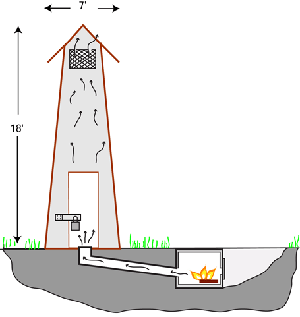
Large items would be cold smoked for 2-3 weeks and smaller products for 10 - 12 days. Unusually tall smokehouses with a free-standing source of smoke were employed to produce cold smoke. Then the finished products were covered with a 2 - 3 mm (0.1") layer of wax to prevent drying. What must be mentioned is that juniper twigs ("juniperus"-gives gin its characteristic flavor) were commonly added to wood logs during smoking to create a specific flavor.
Sometimes juniper berries would be added but those most often would be added directly to meat, either in whole or ground form. Juniper sausage ("jałowcowa") has been made in Poland for as long as anybody can remember. For thousands of years, sausages were originally made by cutting meat into smaller pieces and stuffing them into casings through a suitable funnel, often called a stuffing horn. Most old-timers are familiar with the "Palcówka Sausage" that derived its name from the word fingers (place), which were used to stuff the sausage.
There were continuous wars in the XVII, XVIII, and XIX centuries, and only after the end of WWI in 1918 did we see making sausages becoming an art. The country was a capitalistic state now, and many great sausage-making businesses opened up and flourished. The first books on regional cooking and sausage-making started to appear.
Between the Wars Period - 1918-1939
After the First World War ended in 1918, there was no centrally organized meat industry. There were hundreds of small meat plants and butcher shops across the country that made products in a slow, traditional way using primitive equipment. City-owned slaughterhouses provided services to individual butcher shops. Large slaughterhouses had some cooling facilities, but smaller houses located in little towns did not. The Czerniewice Meat Plant was one of the first large industrial meat plants and started working in 1912 exporting bacon to England. The plant would buy pigs from local farmers and process meat into finished products. Another known plant located in Motycz specialized mainly in the production of bacon. Bacon would go to England, hams to America and canned hams and dry sausages to Africa. That was a typical method of operation for about two thousand Polish plants in the years 1930-1938. From 1932 on, more and more factories started to make canned hams and butts for export, although the production was still limited to small plants.
The World War II - 1939-1945
Due to Polands’s very unique geographical location (the East meets the West) there were always wars taking place on its territory. Always problems with the Russians and the Germans. When Napolean tried to conquer Russia, his armies marched through Poland on the way to Moscow, and when he retreated the Russians chased him again through Poland. The same happened during WWII, the war did not stop in Poland for a second and either Germans were chasing Russians or the Russians were chasing Germans with Poles fighting them both. Poland was the buffer zone, a boiling pot where fighting never seemed to stop. When the war ended 20% of the Polish population (6.5 million) was dead and some cities were completely destroyed.
The horses and cattle were decimated but the pigs escaped to the forests and returned back when it was safer. As there was no industry and no farm machinery the agriculture had to be rebuilt using horses and cattle. Pork was the meat of the necessary choice and the products had to be cured and smoked to be preserved for later use as there was no refrigeration. During the war Germany took over Czerniewice meat plant to produce meats for its military. In 1950, the plant was back in Polish hands and it resumed its meat production. Better equipment was installed and the plant started producing the whole assortment of meats and sausages for export and for the local market.
In the 1990s, after the fall of the government, the plant was in deep trouble and declared bankruptcy in 2000. A year later the plant was taken over by the Polish company "Mat" and has been continuing its operations until today.
The Glory Years (1945-1989)
During WWII (1939 - 1945), most meat plants were destroyed and the re-birth was very slow. In 1948, only about 600 slaughterhouses were in operation. Creating a new, modern, and prospering meat industry became a necessity for the government. The country’s currency "zloty" was not convertible; the government needed hard currency, and the only way to get it was to export raw (coal) materials or finished goods (vodka, meat products) and the government spared no effort to create the best meat industry.
A peculiar characteristic of the new regime was its fondness for long-term planning:
3-year plan (1947-1949) - rebuilding damages and re-growth of animal herds.
6-year plan (1950-1955) - modernization and development of the meat industry. Mechanical methods of slaughter were introduced, new plants were built and older ones were modernized. More types of meats, sausages, and canned products were produced, both for export and for the local needs.
5-year plan (1956-1960) - further modernization and development of the meat industry. Specifically designed machines were introduced to facilitate faster and more economical cutting and carving of animals and newer methods of production were implemented. Huge diversification of meat products was visible. The assembly line production concept was introduced. Meat technology manuals with manufacturing instructions and detailed recipes were written to be used in meat plants in order to produce a consistent and high-quality product. That was the beginning of the Golden Era of Polish Sausages.
Until 1945, a sausage of the same name had many variants, and although the basic recipe remained the same, different regions used different spices which led to different qualities of the product. A typical example was the sausage known as Kabanosy, which, in 1920-1930, started to appear in all areas of the country. In 1945, someone in the newly organized government came up with a brilliant idea of standardizing Polish meat products using traditional time-proven recipes.The official list of meat products and sausages was drawn and the Department of the Meat Industry started to work out details.
In 1959 the first official guide for making meat products and sausages was issued. Its name was # 16 Collection of Recipes and Instructions for Making Meat Products and Sausages and it was reserved for internal use only. At 300 pages long, it had sections on meat curing, making brines, grinding and emulsifying, cooking, and methods of smoking; the whole factory process was described in detail. It covered 31 smoked products (hams, butts, loins, bacon, 46 sausages, 11 headcheeses, and 13 liver and blood sausages. In 1960 the # 17 version was issued which was a slightly revised version of # 16.
Then, in 1964 the Polish Government issued an expanded version called # 21 Collection of Recipes and Instructions for Making Meat Products and Sausages. It was 760 pages long and included: 39 smoked products (hams, loins, bacon, ribs), 119 sausages, 12 headcheeses, 19 liver and blood sausages, and 11 pates and meat loaves. In total 200 meat products were covered and.... now comes the best part....ONLY ONE chemical was used. The additive was potassium nitrate, which had been used for centuries and is still used today by all meat processors, although it is replaced by its easier-to-administer cousin - "sodium nitrite". In fifty years millions of pounds of meat products and sausages were made and sold without the use of chemicals. Just quality meats and spices.
Those government manuals helped to create the best meat industry that ever existed anywhere though its life was only about 50 years.Those manuals were not written by restaurant cooks or college students, but by the best professionals in meat science the country had. The recipes presented on our website come from these manuals.
The project was government-funded and no effort or money was spared. This standardization allowed Poland to produce sausages of high and consistent quality. Moreover, it taught people what to expect from a particular brand, as its taste, texture, color, and flavor were basically the same in all areas of the country. On top of that, all meat plants and retail stores belonged to the government, hence, meat inspectors rigidly enforced the regulations. Suddenly the Kabanosy or Krakowska Sausage tasted exactly the same even when produced in different regions of the country. In 1948 Kabanosy was officially approved as the product name that would be sold in Polish meat stores. In 1954, production instructions were worked out, and in 1964 taking under consideration the traditional recipes of the product, the Government adopted the standard recipe that became the legally binding document that could not be changed.
Although those products were of such high quality, their recognition and popularity was mainly limited to Poland. The country was behind the Iron Curtain, its communist system was the worst evil the world has ever known, there was always a possibility of a new war and the Polish currency was not convertible. Those were not helpful conditions for trading sausages between countries of opposite political systems. From that time until the collapse of the system in 1989 Kabanosy and other meat products were always made the same way. This uniform quality enforced by the government meat inspectors made them very famous Polish sausages. Some sausage makers were lucky and rich enough to bribe their way out to get a passport, while others simply defected crossing the border between Yugoslavia and Italy. Those people brought the taste of Polish sausages to the USA and other countries.
The war damage and the general poverty did not provide the right conditions for the fast rebuilding of agriculture. Farmers raised pigs in traditional ways, feeding them with potatoes, grains, and kitchen leftovers. The chemical industry was in its infancy; there were no fertilizers and cow manure was used, so everything was organic. Those were not conditions that would favor the growth of the economy but they were the ideal conditions for raising animals of the highest quality meat possible. Those high-quality meats, great recipes without chemicals, and good manufacturing practices allowed to make great products. Those government manuals covered not only sausages but also hams, bacon, loins, butts, ribs, picnics, and all meats that could be boiled, baked, smoked or dried. There are still Master Butchers and Sausage Makers from that era and they have been holding on to those publications all their lives. We are very fortunate to have them as members of our site www.wedlinydomowe.pl and our discussion forum. Those people are walking encyclopedias of sausage-making knowledge, and to them, we are deeply indebted.
The Polish ham "Krakus" brand became the best ham in the world and the sausages that were exported had to conform to the highest standards. At that period, between the end of the war and the collapse of the communist system Polish meat products were made the best ever. The decline in Polish meat products is synonymous with the fall of the Berlin Wall and the subsequent collapse of communism. This opened Polish borders to free trade with the West and created new business ventures between Poland and other European countries. Poland became a new undeveloped market and the capital started to flow in. European standards for making meat products were more relaxed than those in Poland, and some countries feared competition from Poland once it became a member of the group. As we mentioned, the only chemical used in Polish meats or sausages was potassium nitrate even though the list of food additives allowed in Europe was long and impressive. It starts at E 100-Curcumin and ends at E1518-Glyceryl Triacetate. In total 1418 different ingredients can be introduced to the food we consume.
The story goes that when Poland was invited to join the Common Market, it was granted an exception and was permitted to use any quantities of food additives in its sausages. Kind of a catch up game: "jump on the waggon guys and start putting chemicals in your products". Soon many meat processors established joint ventures loaded with capital and new partners. That allowed them to bring the latest technology meat machines, and the products were made faster and cheaper. Factory-made curing solutions were injected by brine injectors into meat to shorten curing time and increase the gain of the product. This peaceful revolution came so suddenly that the new government was not able to control all that was happening. The meat industry imported the latest machinery and chemicals from other European countries and started to follow the same standards of production. Unfortunately, those standards were much lower than the high-quality sausage standards that were enforced by the former Polish regime.
When Poland officially joined the Common Market in 2004 the situation deteriorated even further. Now, the country had to conform to new common for all regulations and that did not make sausages any better. For example, in the 1900s, the Polish government allowed 1.5 mg (150 parts per million) of phosphates to be added to 1 kg of meat (phosphates increase meat’s water-holding capacity). New standards allowed 5 mg of phosphates, and of course, manufacturers embraced the idea as it amounted to higher profits. On the other hand now an average Polish consumer had to swallow three times more chemicals than before and was buying a product with more water in it. Common Market policies have affected other countries as well. For instance, Germany never allowed the use of liquid smoke in its products. When the country became a member of the European Common Market, it had to conform to new regulations and liquid smoke is now added to meat products. Unfortunately, hundreds of smaller sausage makers who made wonderful products, could not compete with larger companies and went out of business. Very few managed to survive by charging higher prices for their superior products and catering to a more demanding consumer.
Trade Associations (Cechy)
In XIII-XVIII century Poland, there were trade associations (cechy) which enlisted highly trained and experienced members in their particular field. Membership was in high demand as those organizations provided many benefits to their members who in turn gained financial wealth. They also performed the following functions:
- Provided exclusive rights to supply and sell products in a particular city or geographical area
- Enforced proper manufacturing methods to make sure that their products were of the highest quality
- Enforced that delivered meat conformed to standards
- estimated market demand and accordingly controlled supply
- Provided specialized training to new would-be members
The trade organization structure remained basically the same. What varied was the amount of power they held. Originally, they were very strong monopolistic organizations that protected the interests and markets of their members. This type of structure continues to this day, though it may be called a worker’s or trade union.
The first sausage-making trade organizations were established in the XIII century in Kalisz and Torun (birthplace of Nicolaus Copernicus), then in the XIV century in Wroclaw and Szczecin. In the XV century, such organizations prospered in every larger city. At the end of the XV century, the trade unions made it very difficult for new members to join them. The apprenticeship was made longer, membership fees went higher and no new seats were created. That was done to limit competition and stabilize prices at the same level. Unfortunately, this course of action largely backfired as more people got involved in the sausage-making trade by bypassing trade unions.
Then came a few centuries of very turbulent history and trade unions lost much of their enforcing power. Eventually, they became training centers and issuers of trade licenses. This is a similar process to any licensed trade in the USA: first, you become an apprentice, then a journeyman, and then, after passing a state exam, you become a licensed contractor, plumber, or electrician. Although they could not control the market the way they once did, they provided a great service by educating and licensing people who chose sausage making as a career.
All individually owned businesses, sausage-making included, had to belong to the regional trade association that held jurisdiction over that area. Only there could they sign up for new courses, take exams, and become members of the group. That allowed them to buy materials that were not available at the market at large, but were centrally distributed by the government to people that provided much in product demand or service. They were also issued new recipes and only they were authorized to make those sausages. For the struggling economy, materials like fuel, meats, and sausages were of utmost importance for the country’s survival. As Napoleon Bonaparte once said: "The army marches on its stomach".
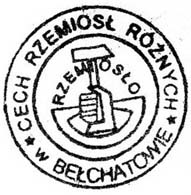
Crest of the City of Belchatow Trade Association
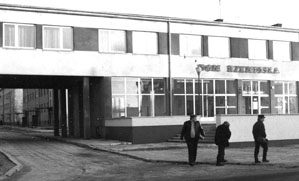
Belchatow City Chamber of Commerce-Sausage Makers Trade Association still functions inside the building. It was re-established after the end of the war and its first function was to work on new government standards for sausages.
The meat industry and its distribution were centralized and so important for the government that any deviation in the recipe or adding food additives not called for was punishable by law. There were a few larger affairs where dishonest operators included cheap meat substitutions to increase profits and we know of two cases where responsibles were sentenced to death and executed. This may sound as a joke but, "if today’s recipes and manufacturing methods were somehow introduced to the meat inspectors in 1959-1989 Poland, there wouldn’t be enough jail cells to accomodate meat plant managers".
Which Way Are We Going?
There is an enormous interest in the traditional methods of food preparation. A customer is well aware of the present state of the meat industry and expects his products to be healthy. There is a universal dislike towards chemicals and people want to know what goes inside. And they start to make those products at home if only once or twice a year. After just one year our organization Wedliny Domowe has grown so much that its First National Convention took place in August 2006. In addition to hundreds of attendees, a number of professional courses and demonstrations were offered. In August 2024 there was the 20th anniversary of our activity.
Wedliny Domowe First National Convention - August 26-28, 2006
With all due respect to the Polish meat industry, we can say that although the recipes remain basically correct, binders, fillers, and chemicals are widely used in order to improve yield and profits. That is why there is such an interest in homemade products as people want the old quality and taste. It is not realistic to expect that a person will make himself sausages all the time, but it is feasible that he might do it once for Christmas and another time for Easter, exactly as it was done 100 years ago.
Although we do love the latest achievements in science and technology, we feel that the simple time-proven methods of sausage manufacturing still create higher-quality products. It may not last as long on the shelf or in a refrigerator, it may lose its pink color sooner, but it will definitely taste better. I do not care much how pretty and plump they are, as they will not hang on the wall among my paintings and photographs. I am going to eat my sausages and I want them to be good.
As we have mentioned before the best quality sausages were made in Poland until the collapse of the Berlin Wall in 1989. Then, in 2004 Poland joined the European Common Market, and the situation deteriorated even further. Joining an organization of this kind is like living in a community-controlled apartment complex. You lose your freedom and decision-making and have to submit to regulations that are forced on you, be it the height of the grass on your lawn, the number of guests you can accommodate overnight, or what time you can make noise.
Reprinted with permission from the book Polish Sausages

